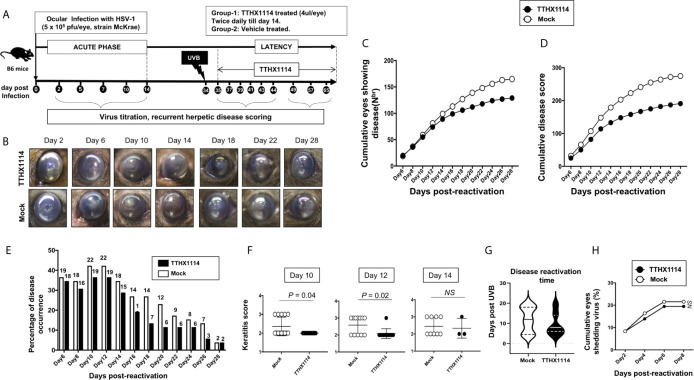Figure 3.
Effect of FGF-1 treatment on recurrent ocular herpes mouse model of UVB-induced herpes reactivation: Wildtype B6 mice were infected with HSV-1(McKrae 5 x 106 pfu/eye and at day 35 p.i, eyes were reactivated by exposure to UV-B radiation for one minute. One group of mice was mock treated (n=26) while another group was treated topically with FGF-1 (n=26) from day 34 p.i for two weeks (two doses each day). (A) Experimental plan for testing the effect of FGF-1 on mouse model of ocular herpes reactivation. (B) Representative mouse eye picture of herpes UV-B reactivated mice treated with FGF-1. (C) Cumulative number of eyes with reactivated disease in mock and FGF-1 treated mice group from day6 to day 28 post-reactivation is shown. (D) Graph showing cumulative disease score in mock and FGF-1 treated mice group from day6 to day 28 post-reactivation. (E) Percentage of disease occurrence in mock treated and FGF-1 treated mice group from day 2 to day 28 post-reactivation. Number above each bar represents the number of eyes showing disease out of 52 eyes. (F) Graph showing keratitis score (more than 2) in mock and FGF-1 treated at day10, day12 and day14 post-reactivation. (G) Duration of recurrent corneal herpetic disease in HSV-1 infected mice following treatment with FGF-1. The violin plot illustrates the distribution of disease duration post UV-B radiation in days between mock and TTHX1114 treated groups. Note the higher number of eyes displaying disease for more than 10 days in the mock group compared to TTHX1114 treated mice. Only eyes with disease score above 2 for both mock and treated groups were included in this analysis. (H) Graph showing cumulative number of eyes shedding virus in TTHX1114 treated and mock treated mice, estimated by viral plaque assay in eye swabs. NS, not significant.

